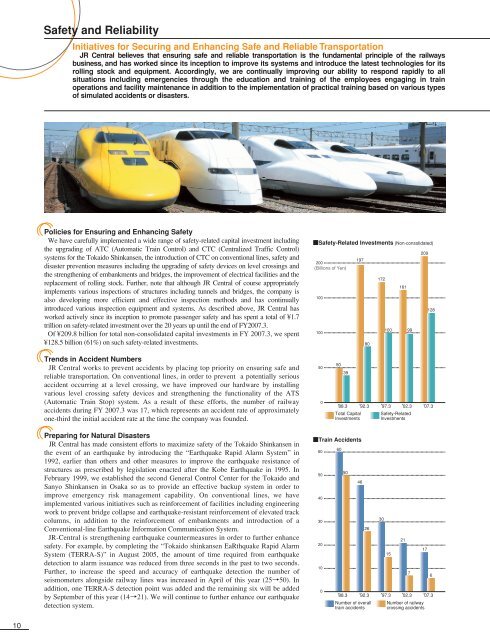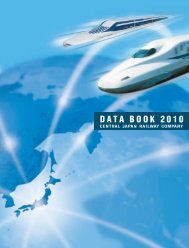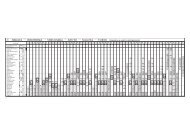CENTRAL JAPAN RAILWAY COMPANY Annual Report 2007
CENTRAL JAPAN RAILWAY COMPANY Annual Report 2007
CENTRAL JAPAN RAILWAY COMPANY Annual Report 2007
Create successful ePaper yourself
Turn your PDF publications into a flip-book with our unique Google optimized e-Paper software.
Safety and Reliability<br />
Initiatives for Securing and Enhancing Safe and Reliable Transportation<br />
JR Central believes that ensuring safe and reliable transportation is the fundamental principle of the railways<br />
business, and has worked since its inception to improve its systems and introduce the latest technologies for its<br />
rolling stock and equipment. Accordingly, we are continually improving our ability to respond rapidly to all<br />
situations including emergencies through the education and training of the employees engaging in train<br />
operations and facility maintenance in addition to the implementation of practical training based on various types<br />
of simulated accidents or disasters.<br />
Policies for Ensuring and Enhancing Safety<br />
We have carefully implemented a wide range of safety-related capital investment including<br />
the upgrading of ATC (Automatic Train Control) and CTC (Centralized Traffic Control)<br />
systems for the Tokaido Shinkansen, the introduction of CTC on conventional lines, safety and<br />
disaster prevention measures including the upgrading of safety devices on level crossings and<br />
the strengthening of embankments and bridges, the improvement of electrical facilities and the<br />
replacement of rolling stock. Further, note that although JR Central of course appropriately<br />
implements various inspections of structures including tunnels and bridges, the company is<br />
also developing more efficient and effective inspection methods and has continually<br />
introduced various inspection equipment and systems. As described above, JR Central has<br />
worked actively since its inception to promote passenger safety and has spent a total of ¥1.7<br />
trillion on safety-related investment over the 20 years up until the end of FY<strong>2007</strong>.3.<br />
Of ¥209.8 billion for total non-consolidated capital investments in FY <strong>2007</strong>.3, we spent<br />
¥128.5 billion (61%) on such safety-related investments.<br />
Safety-Related Investments (Non-consolidated)<br />
<br />
<br />
<br />
(Billions of Yen)<br />
<br />
<br />
<br />
<br />
<br />
<br />
<br />
Trends in Accident Numbers<br />
JR Central works to prevent accidents by placing top priority on ensuring safe and<br />
reliable transportation. On conventional lines, in order to prevent a potentially serious<br />
accident occurring at a level crossing, we have improved our hardware by installing<br />
various level crossing safety devices and strengthening the functionality of the ATS<br />
(Automatic Train Stop) system. As a result of these efforts, the number of railway<br />
accidents during FY <strong>2007</strong>.3 was 17, which represents an accident rate of approximately<br />
one-third the initial accident rate at the time the company was founded.<br />
<br />
<br />
<br />
<br />
<br />
Total Capital<br />
Investments<br />
Safety-Related<br />
Investments<br />
Preparing for Natural Disasters<br />
JR Central has made consistent efforts to maximize safety of the Tokaido Shinkansen in<br />
the event of an earthquake by introducing the “Earthquake Rapid Alarm System” in<br />
1992, earlier than others and other measures to improve the earthquake resistance of<br />
structures as prescribed by legislation enacted after the Kobe Earthquake in 1995. In<br />
February 1999, we established the second General Control Center for the Tokaido and<br />
Sanyo Shinkansen in Osaka so as to provide an effective backup system in order to<br />
improve emergency risk management capability. On conventional lines, we have<br />
implemented various initiatives such as reinforcement of facilities including engineering<br />
work to prevent bridge collapse and earthquake-resistant reinforcement of elevated track<br />
columns, in addition to the reinforcement of embankments and introduction of a<br />
Conventional-line Earthquake Information Communication System.<br />
JR-Central is strengthening earthquake countermeasures in order to further enhance<br />
safety. For example, by completing the “Tokaido shinkansen EaRthquake Rapid Alarm<br />
System (TERRA-S)” in August 2005, the amount of time required from earthquake<br />
detection to alarm issuance was reduced from three seconds in the past to two seconds.<br />
Further, to increase the speed and accuracy of earthquake detection the number of<br />
seismometers alongside railway lines was increased in April of this year (2550). In<br />
addition, one TERRA-S detection point was added and the remaining six will be added<br />
by September of this year (1421). We will continue to further enhance our earthquake<br />
detection system.<br />
Train Accidents<br />
<br />
<br />
<br />
<br />
<br />
<br />
<br />
<br />
<br />
<br />
<br />
Number of overall<br />
train accidents<br />
<br />
<br />
<br />
<br />
<br />
<br />
Number of railway<br />
crossing accidents<br />
<br />
10





